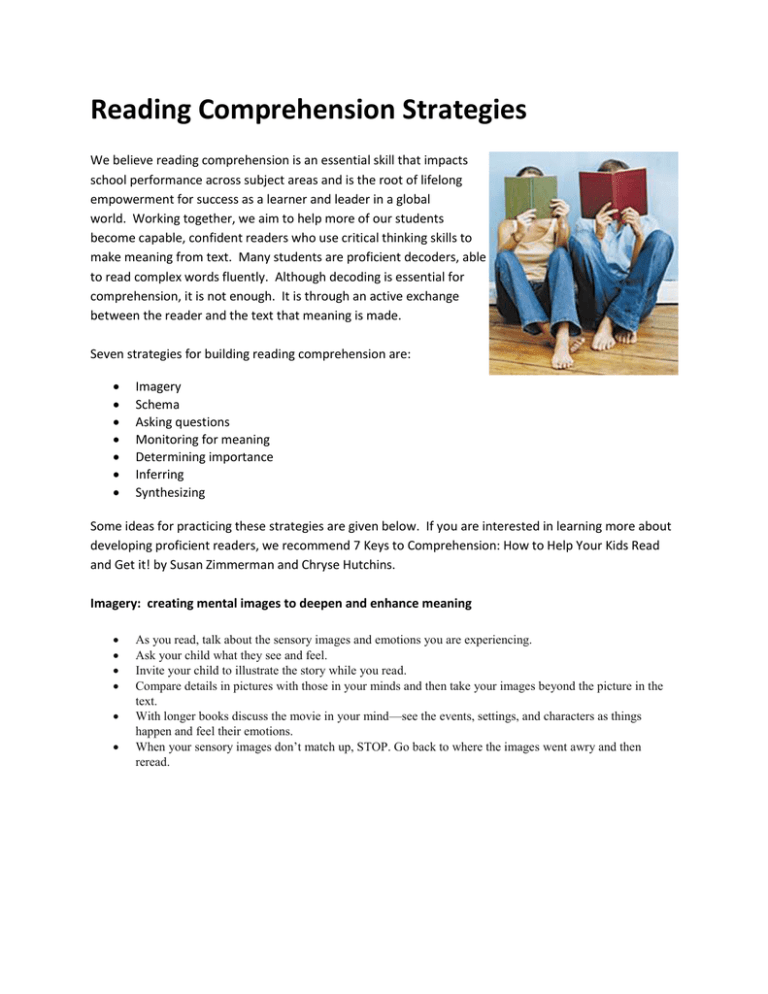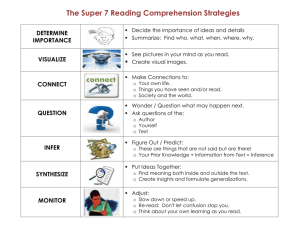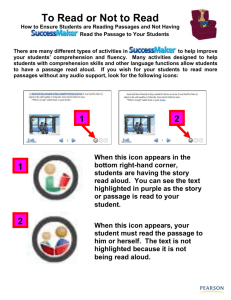Reading Comprehension Strategies
advertisement

Reading Comprehension Strategies We believe reading comprehension is an essential skill that impacts school performance across subject areas and is the root of lifelong empowerment for success as a learner and leader in a global world. Working together, we aim to help more of our students become capable, confident readers who use critical thinking skills to make meaning from text. Many students are proficient decoders, able to read complex words fluently. Although decoding is essential for comprehension, it is not enough. It is through an active exchange between the reader and the text that meaning is made. Seven strategies for building reading comprehension are: Imagery Schema Asking questions Monitoring for meaning Determining importance Inferring Synthesizing Some ideas for practicing these strategies are given below. If you are interested in learning more about developing proficient readers, we recommend 7 Keys to Comprehension: How to Help Your Kids Read and Get it! by Susan Zimmerman and Chryse Hutchins. Imagery: creating mental images to deepen and enhance meaning As you read, talk about the sensory images and emotions you are experiencing. Ask your child what they see and feel. Invite your child to illustrate the story while you read. Compare details in pictures with those in your minds and then take your images beyond the picture in the text. With longer books discuss the movie in your mind—see the events, settings, and characters as things happen and feel their emotions. When your sensory images don’t match up, STOP. Go back to where the images went awry and then reread. Schema: Making connections between the story and what you already know; using background knowledge to understand the text Show your child how you connect new information to your background knowledge and invite them to do the same. o "This reminds me of . . . " o "I remember when I read . . . " o Share when you learn something new. o "I think I'll connect this new idea to . . . Make your thinking visible. With longer books, keep sticky notes on hand and place them on edges of the pages when the reader makes a connection. Asking Questions: Thinking of questions before, during, and after reading to lead you to a deeper understanding and promote involvement with the story Begin by demonstrating your own process of questioning by sharing an unfamiliar text and stopping at regular intervals to “think aloud” about the questions running through your head. Use post-it notes to write questions upon and stick on pages in the book to use as page holders for the pages about which you have questions. Going back to the post-it note questions and seeing if your reading has answered your questions is quite fun & doing it together produces higher level questions, as your questions are often richer due to the conversation you are having. Monitoring for Meaning: Knowing when you understand and when you don't understand Children benefit from hearing adults think aloud as they read. When you are reading aloud with your child, stop and say: o "Wait, I am not understanding. I am going to go back and re-read." o "I wonder why the character is choosing to do that? I'm going to keep reading to see if I can figure it out." o "What does that word mean? I will use context clues to figure it out or use the dictionary." Work with your child to create a list of fix-up strategies to use while reading: keep reading, re-read, ask questions, think about background knowledge, use a dictionary, ask for help, et cetera. Re-read difficult texts with your child. A second read of a challenging text makes it possible to understand the concepts at a deeper level. Ask your child to keep track of their inner voice . . . what do they understand and what don't they understand. Ask him/her to identify what they are not understanding (a word, a sentence, a paragraph, the concepts, the message/lesson of the text). Determining Importance: Deciding what matters most and what is worth remembering Access Prior Knowledge: "What do you know about ___________?" Note the text features: titles, bold headings, pictures with captions, quotations, timelines, graphs and maps give valuable information about what’s important. Determine what is important. o What is the reader’s purpose? o What questions directed the reading initially? o Is there a need for specific information? As you read the passage, ask or point out: o What is most important? o What is essential to remember? o Compare a few of those ideas and determine which ideas hold more importance to the whole piece? And, what was just interesting? How did you decide? o Frequently point out what is unimportant. This helps students distinguish more clearly what is important information. Inferring: Using what you already know with information from the text to predict, conclude, make judgments, and interpret "Figure out explanations for these events." "Think about the setting and see what details you can add." "Think about something that you know about this (insert topic) and see how that fits with what’s in the text." "After you read this section, see if you can explain why the character acted this way". "Look at how the character said (insert a specific quote). How would you have interpreted what that character said if he had said (change how it was said or stress different words)?" "Look for words that you don’t know and see if any of the other words in the sentence or surrounding sentences can give you an idea for what those unknown words mean." "As you read this section, look for clues that would tell you how the author might feel about (insert a topic or character’s name)." Synthesizing: Using ALL comprehension strategies to deepen your understanding of the text "During and/or after reading this passage how has your thinking changed about plot, character, theme?" What do you think the author’s message is and why?" "As you read through this passage, show me where you noticed your ideas changing." "What do you want to take away with you after reading this book and why?"


